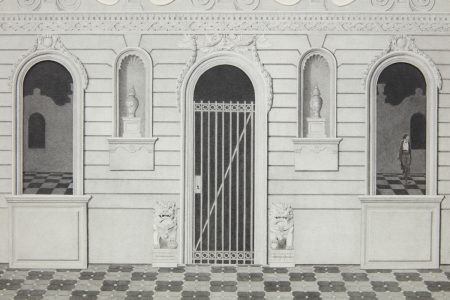Milano Chow’s intricate black-and-white drawings at Bel Ami depict a dreamy world where decorous women peer out of elegant townhouses and pose languidly against ornate clocks that seem to double as architectural follies. This show, “Park La Brea,” is titled after an iconic Los Angeles mega-development of mid-century apartment buildings. However, despite its plausible reference and finely detailed guise, Chow’s realm lies decidedly far from concrete reality, a fact that becomes more and more apparent the longer one looks: Spatiality is shallow; perspective is flattened; everything is too perfect. Eerily bereft of individuality, the structures and inhabitants alike seem to exist for the sake of being viewed from a certain angle, like paper dolls arranged inside a miniature house. Underscoring this sensation are two paper dioramas, including Corner (2019), where a cutout lady peeks playfully at the viewer from behind a decorative shoji.

Chow’s generically comely female protagonists are models lifted from fashion photos; the spaces they occupy were devised after pictures and elevations from architecture books. For all their stately contrivance, the setups feel comfortless, and at times surreal. In Checkered Floor I (2020), which recalls De Chirico’s compositions, a smartly dressed figure is spied sashaying across the titular expanse between two colonnades: the foreground an ornate facade, the background a shadowy phantom.

At present, it’s easy to read quarantine narratives into these scenes of lone figures in empty domestic spaces. However, not all were executed in 2020; and in fact, Chow has been producing work in this trajectory for the past several years. Perhaps the pandemic has only accelerated a long-term societal trend of alienation. Popular genres purporting to offer peeks into strangers’ inner lives—such as reality shows, confessional essays, and personal photos and video clips posted online—conveniently offer specious salves to anomie. In the press release, Chow posits her windows and doors as metaphors for screens, a notion that might not otherwise be obvious. But her scenarios are, indeed, suffused with an air of manufactured voyeurism not unlike that which pervades the world refracted through the Internet. One nascent trope of pseudo-intimacy that comes to mind during the quarantines is the conspicuous display of family photos and curios too small to clearly apprehend just behind news commentators and interviewees webcasting from home. Chow’s work here suggests that such glimpses into others’ ostensibly private lives are no more revealing than peeping through the drapes of a shallow dollhouse.
–Annabel Osberg
Milano Chow, “Park La Brea,” Oct. 21-Dec. 5, 2020 at Bel Ami, 709 N. Hill St, inside Asian Center, upstairs suite #105, Los Angeles, CA 90012, belami.info